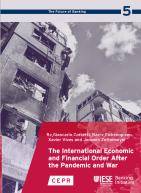The authors discuss how the complex macroeconomic environment impedes efforts to resolve the current inflation crisis and presents a substantial challenge to the economic policy model. Both a stable fiscal outlook and a credible monetary policy are key for stability, yet this may prove difficult without first addressing financial vulnerability. The report recommends adjusting relative prices and wages in response to recent supply and demand shocks and strengthening the interaction between monetary, fiscal, and regulatory policies to reduce vulnerabilities, decrease risks of a confidence crisis, and facilitate deleveraging at minimal economic and social cost.
The gradual weaponisation of the US dollar has raised fundamental questions over the direction of the international monetary landscape and has created an opportunity for the exploration of alternative reserve currencies. China has acted quickly, introducing the first central bank digital currency, e-CNY, for cross-border transactions, and positioning the renminbi as a legitimate rival to US banks and SWIFT. Yet, the report argues that we are more likely to see a gradual decline in the dominance of the US dollar, as the alternatives are still of limited utility. A more pressing concern, however, is a breakdown in relations between China and the US, which could lead to increased polarisation of the international financial system and cause severe ramifications for trade.
Despite higher debt and long-term real interest rates, debt remains sustainable in most advanced countries and emerging market economies. However, a subset of EU countries (Belgium, Czech Republic, Finland, France, Greece, Italy, the Netherlands, Romania and Spain), remain particularly vulnerable, with significantly more debt adjustment needed than is currently planned over the medium term. To avoid a debt crisis in Europe, the authors provide a roadmap for EU fiscal reform that stabilises and reduces debt ratios while preserving incentives for investment. For emerging economies under the burden of debt distress, meanwhile, measures must be put in place to increase non-debt-creating financial support, strengthen bond contracts linked to climate risks and climate policy, and improve coordination among official creditors.
In sum, this report illustrates how the twin shocks to the global economic and financial order have exacerbated past threats and created potential conflicts between the policy aims of controlling inflation, making debt sustainable and maintaining financial stability. The authors’ recommendations can help policymakers navigate the increasingly volatile policy space and reform the economic policy model to achieve greater stability.



